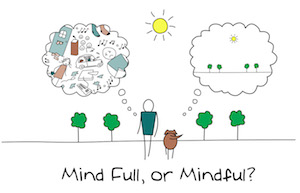 Does the word meditation conjure up images of monks in saffron robes or new-age mantras? Meditation isn’t about religion per se, but it is about training your brain to bring your thoughts and feelings into awareness – it teaches you to appreciate every moment for what it is. Meditation strengthens the mind. It can change a full mind to being mindful of the present moment.
Does the word meditation conjure up images of monks in saffron robes or new-age mantras? Meditation isn’t about religion per se, but it is about training your brain to bring your thoughts and feelings into awareness – it teaches you to appreciate every moment for what it is. Meditation strengthens the mind. It can change a full mind to being mindful of the present moment.
Since time immemorial the benefits of meditation on the mind, body and soul have been known, but maybe it is even more relevant today in our constantly busy world. Over recent times scientific studies have been able to conclusively reveal the effects of meditation on the brain, including stress reduction, improved attention, better memory, increased creativity and an increase in compassion. Meditation and Mindfulness increase the all-important grey matter in the brain, especially in areas important to muscle control, sensory perception, memory, emotions and speech. One study at the Massachusetts General Hospital found that people who meditated for 30 minutes a day for only eight weeks measurably increased the hippocampus, a part of the brain vital for memory and learning, and the amygdala which is connected to stress and anxiety.
A 2012 study by Robert Schneider and his associates reported in the American Heart Association journal that meditation can reduce the risk of heart attack and stroke by controlling stress.
Many of the benefits of mindfulness meditation can’t be measured scientifically, yet proponents tell us it impacts on how you approach life, react to situations, and how you interact with other people. It brings a sense of calmness and acceptance of life.
Mindfulness has become a bit of a buzz-word. At its simplest, mindfulness meditation is being present in the moment and having awareness of the moment with all of your senses.
Start with noticing your breathing. Be aware of the breath entering and leaving your body. As you exhale be thinking ‘calm mind’ and ‘relaxed body’. Be aware of the comfort of the chair you are sitting in, the sounds about you – not listening out for them but just aware of sounds. Try and be right in the moment. At first, you will probably find your thoughts darting all over the place! Quietly bring yourself back to your breathing.
There are many different ways to practice meditation. In the beginning, it can be useful to follow a guided audio meditation or find a good book on it. Don’t let yourself be distracted by thoughts of ‘Am I doing it the right way?’
Wherever you are when you have reached a state of quietness quietly observe what is around you. Really notice! Notice how the sunlight creates shadows, how the breeze gently moves the leaves, enjoy the sensation of stroking your cat, breath in the perfume of flowers, watch birds soaring and darting. You will be astonished how unobservant we usually are and we are distracted by the demands for our attention the modern world brings.
Several people have mentioned a programme called ‘Headspace’. It is available online or as a phone App. It teaches and guides users through 10-minute meditations. Perhaps you would like to have a look at that.
Whatever way to mediation and mindfulness appeals to you, find time each day to experience being totally ‘in the moment’. Your brain, memory, learning, mood, ability to focus and stress will thank you. The benefits are too many to ignore and are well worth a few minutes a day.
By Dr. Allison Lamont
Founder and memory consultant at the Christchurch Memory Clinic.
Stemming from my research into memory and aging, my sister Gillian Eadie and I have founded the Brain and Memory Foundation website. Click here to visit the website.









Join the Discussion
Type out your comment here:
You must be logged in to post a comment.